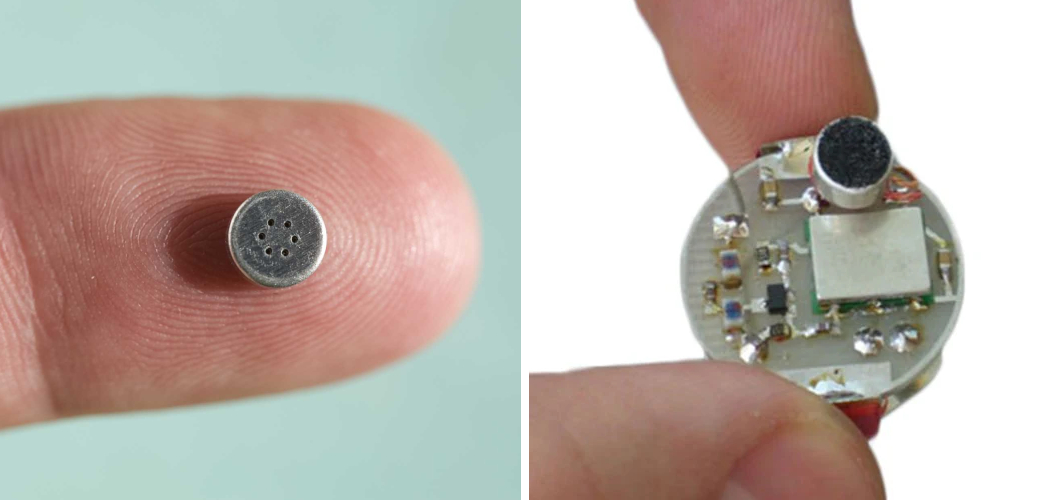Are you concerned about your privacy and suspect that someone is listening to your conversations? You may have good reason to be worried. With advancements in technology, anyone can easily bug a room or place a listening device on your personal belongings without you even knowing.
In today’s age of advanced technology, privacy concerns are more prevalent than ever. Whether you suspect an intruder has planted a bug or you’re simply being vigilant, knowing how to detect a listening device in your home can give you peace of mind. Listening devices can be tiny and easily concealed, making them challenging to locate without the proper knowledge and tools.
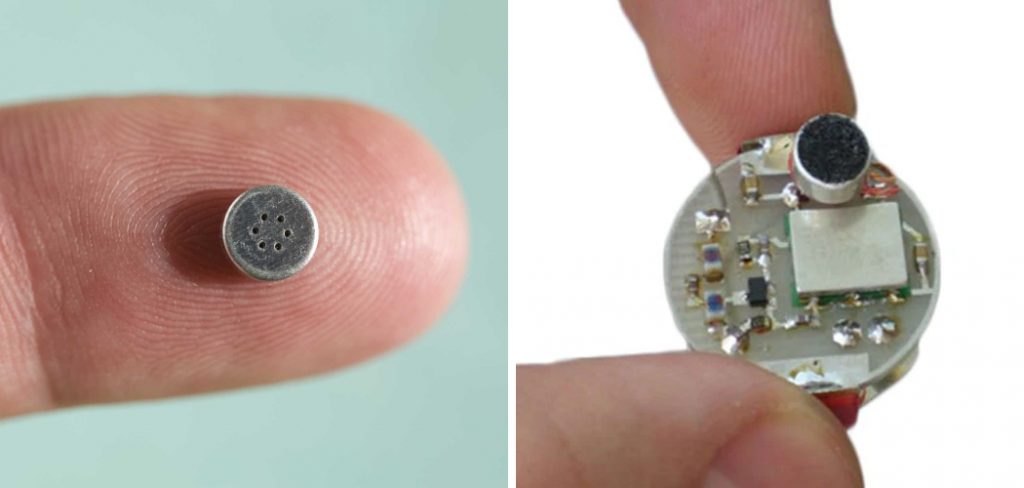
This guide will walk you through various methods and tips on detecting a listening device in your, ensuring your personal space remains secure and private.
What Will You Need?
Before you search for listening devices, gathering the necessary tools and equipment is important. These may include:
- A flashlight
- A signal detector (can be purchased or downloaded as an app on your smartphone)
- An RF detector (radio frequency detector)
- A bug detector
- Headphones
Once you have these tools ready, you can proceed with the detection process.
10 Easy Steps on How to Detect a Listening Device in Your
Step 1. Perform a Visual Inspection:
Begin with a thorough visual inspection of the area you’re concerned about. This step involves carefully examining your surroundings for anything that appears out of place or unfamiliar. Look for small, unusual objects, such as tiny holes in walls, odd-looking screws or fixtures, and new or unfamiliar devices. Pay special attention to common hiding spots like smoke detectors, electrical outlets, lamps, and wall decorations.
A flashlight can help illuminate dark corners and behind furniture where listening devices might be concealed. Move methodically from one section of the room to another, making sure no potential hiding spot is overlooked. Document any suspicious findings for further investigation in the subsequent steps.
Step 2. Use a Signal Detector:
After the visual inspection, your next step is to use a signal detector. Signal detectors can be purchased or downloaded as an app on your smartphone. These devices work by detecting the radio frequencies that many listening devices emit. Turn off all other electronics that could interfere with the detection process and slowly move the signal detector around your room, paying close attention to the areas you inspected visually. If the device detects any unusual signals, note the location for further examination.
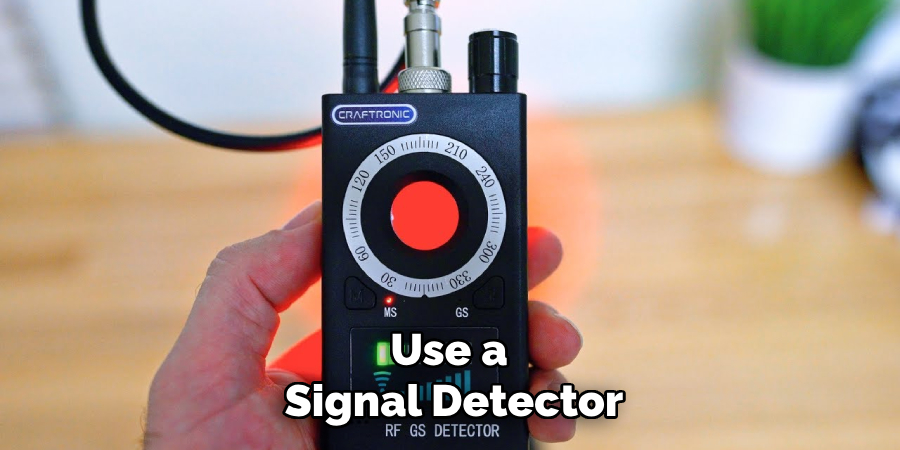
Step 3. Scan for Radio Frequencies (RF):
An RF detector is another valuable tool for identifying listening devices. These detectors are designed specifically to locate the frequencies commonly used by bugs and wiretaps. Begin by turning on the detector and methodically scanning the entire room, including all the nooks and crannies you visually inspected earlier. The detector will beep or light up if it identifies any suspicious frequencies, indicating the possible presence of a hidden listening device.
Step 4. Listen for Unusual Sounds:
Put on a pair of headphones and turn off all electronic devices that could create background noise. In a quiet room, listen carefully for any unusual sounds. Many listening devices produce faint buzzing, clicking, or static noises. Move around the room slowly and listen attentively near common hiding spots, such as light fixtures, wall sockets, and electronic devices.
Step 5. Check Your Wireless Network:
Modern listening devices may connect to your wireless network. Access your Wi-Fi settings through your router’s interface and look at the list of connected devices. If you notice any unfamiliar connections or devices, they might be suspect. Cross-reference this list with the devices you recognize and find their physical locations to investigate further.
Step 6. Inspect Electrical Outlets and Fixtures:
Carefully examine your electrical outlets, light fixtures, and other potential concealment spots. Listening devices can be hidden inside these fixtures, often undetectable without close inspection. Unscrew or disassemble these items if you feel comfortable doing so (and ensure it’s safe to do so), checking for any unusual modifications or objects.

Step 7. Test for Interference:
Listening devices sometimes interfere with electronic gadgets. Turn on a known functioning AM/FM radio and set it to the AM band with no station. Move the radio around the room and listen for any unusual interference or static. This could indicate a hidden device emitting a signal.
Step 8. Utilize a Professional Bug Sweeper:
For thoroughness, consider employing a professional bug sweeper. These experts use advanced equipment and have the experience to locate and verify any hidden listening devices. Though it might involve a cost, professional sweepers can provide a higher level of assurance and expertise.
Step 9. Inspect Common Hiding Spots:
Objects like clocks, picture frames, books, and even teddy bears can be popular spots for hiding listening devices. Conduct a more detailed and hands-on inspection of these items, looking for anything out of the ordinary. Pay extra attention to objects that seem to have appeared unexpectedly.
Step 10. Perform Regular Checks:
Even after your initial sweep, performing regular checks is good practice. Technology is always advancing, and staying vigilant can ensure that your space remains private. Periodically utilize the tools and methods mentioned above to maintain a secure environment.
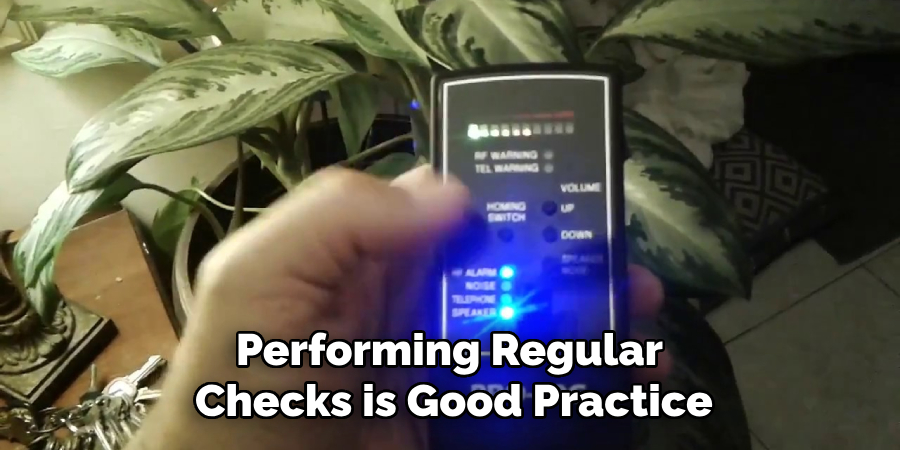
Following these steps can enhance your ability to detect and remove listening devices, safeguarding your privacy and peace of mind.
5 Additional Tips and Tricks
- Inspect Unusual Objects: Common household items such as smoke detectors, power outlets, and picture frames can be altered to house listening devices. Examine these objects closely for any signs of tampering or additions.
- Use a Radio Frequency Detector: A radio frequency (RF) detector can help locate hidden wireless listening devices by scanning for frequencies that are typically emitted by such equipment.
- Pay Attention to Interference: If you notice unusual interference on your electronic devices, such as static on your phone or radio, it could be an indication of a listening device operating nearby.
- Check for Suspicious Network Activity: Use network scanning software to detect unauthorized devices connected to your Wi-Fi network, which could indicate a Wi-Fi-enabled listening device.
- Professional Sweep: If you suspect high-level surveillance, consider hiring a professional team to thoroughly sweep your premises. They have specialized tools and expertise to identify and remove sophisticated listening devices.
With these additional tips and tricks, you can stay vigilant against potential eavesdropping attempts.
5 Things You Should Avoid
- Ignoring Physical Indicators: Overlooking physical signs like out-of-place wires, new vents, or unfamiliar electronic devices could mean missing obvious clues about hidden listening devices.
- Relying Solely on Technology: While gadgets like RF detectors can be useful, they are not infallible. Solely depending on technology may lead you to overlook more traditional surveillance methods.
- Conducting Sweeps Infrequently: Sporadic checks may not be sufficient. Regularly inspect your space to catch any new or moved devices in a timely manner.
- Neglecting Expert Help: Handling sophisticated surveillance threats without professional assistance can result in incomplete detection. Professionals have the necessary expertise and equipment to uncover advanced eavesdropping devices.
- Panic Actions: Rash actions driven by fear, such as dismantling devices without understanding their purpose, can sometimes result in inadvertently destroying important evidence or overlooking more discreet listening devices. Always approach the situation methodically and, if in doubt, consult a professional.
By avoiding these common mistakes, you can improve your chances of successfully detecting and removing any potential eavesdropping devices. Stay vigilant and remember to regularly review your security measures to stay one step ahead of potential threats.
Why Should You Care About Eavesdropping?
Eavesdropping can have serious consequences for individuals and organizations. It can compromise sensitive information, trade secrets, and confidential communications, resulting in financial loss, reputational damage, and legal troubles.
Eavesdropping can violate privacy rights and cause emotional distress in personal settings. In some cases, it may even pose a physical threat if the individual or organization being monitored is engaged in potentially dangerous activities.
By taking steps to prevent eavesdropping and regularly checking for any potential listening devices, you are safeguarding yourself against these risks. Don’t underestimate the importance of protecting your privacy and sensitive information. Stay alert, stay informed, and take action to ensure your space remains free from eavesdropping devices.
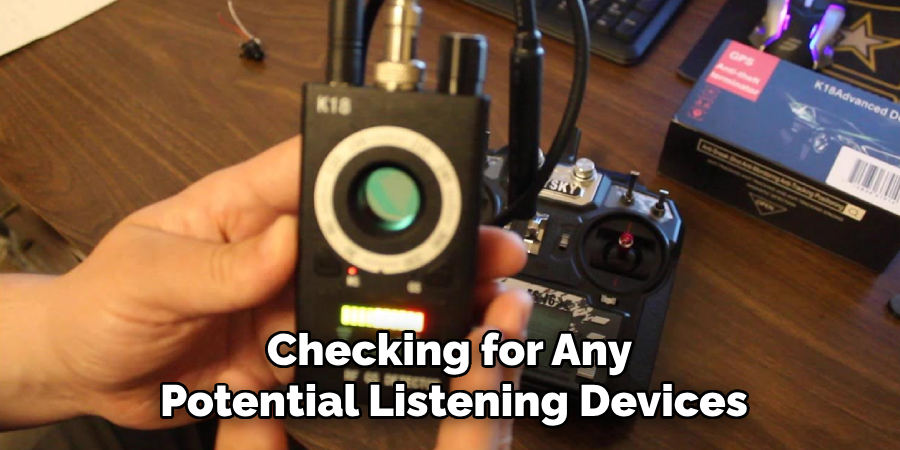
Conclusion
Detecting a listening device in your environment requires vigilance, technology, and professional assistance. Start by inspecting unusual objects and paying attention to any physical indicators of tampering. Utilize tools like radio frequency detectors and network scanners to identify and locate potential listening devices. Regularly conduct sweeps of your premises and remain cautious of relying solely on technology or reacting impulsively. When in doubt, do not hesitate to seek expert help to ensure a thorough and professional inspection.
By taking proactive steps and maintaining a methodical approach, you can effectively protect your privacy and secure your environment from unwanted surveillance.
Hopefully, this guide has provided you with valuable insight and practical tips on how to detect a listening device in your. Remember, staying informed and regularly reviewing your security measures is key to staying ahead of potential threats. Stay informed, stay vigilant, and stay secure.

